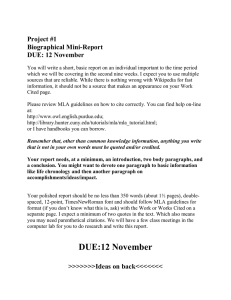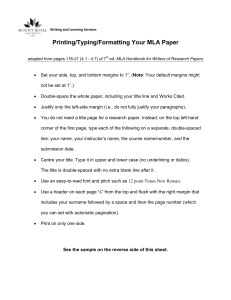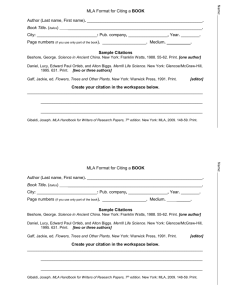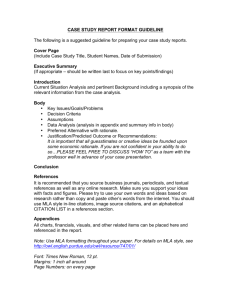Guidelines for Student Papers
advertisement
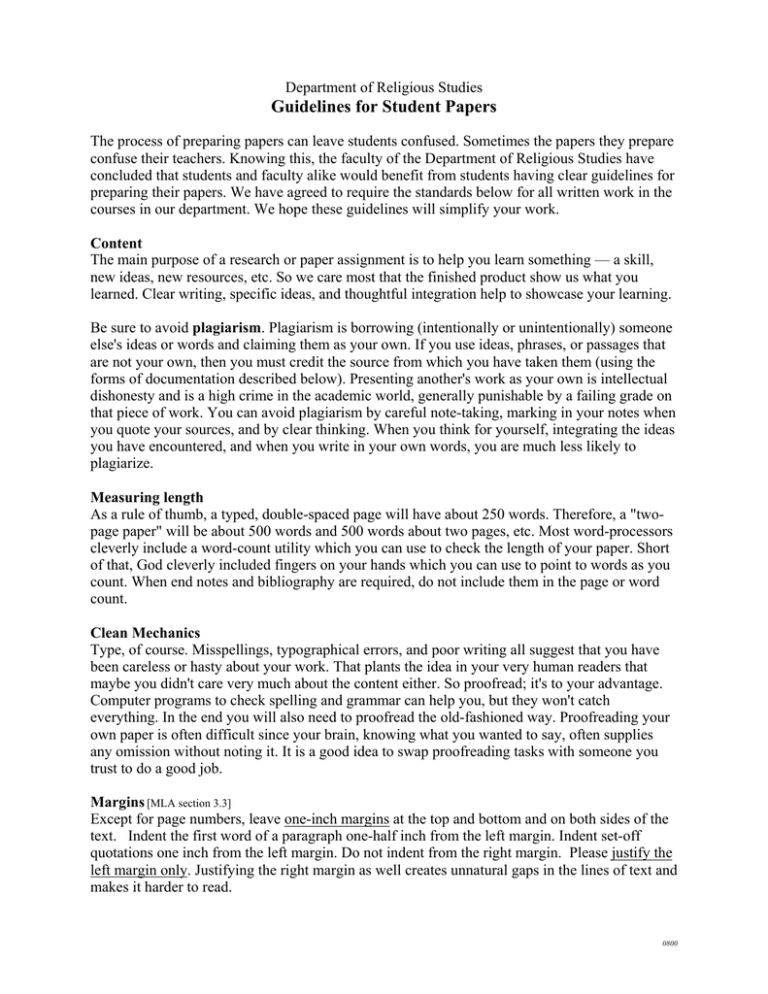
Department of Religious Studies Guidelines for Student Papers The process of preparing papers can leave students confused. Sometimes the papers they prepare confuse their teachers. Knowing this, the faculty of the Department of Religious Studies have concluded that students and faculty alike would benefit from students having clear guidelines for preparing their papers. We have agreed to require the standards below for all written work in the courses in our department. We hope these guidelines will simplify your work. Content The main purpose of a research or paper assignment is to help you learn something — a skill, new ideas, new resources, etc. So we care most that the finished product show us what you learned. Clear writing, specific ideas, and thoughtful integration help to showcase your learning. Be sure to avoid plagiarism. Plagiarism is borrowing (intentionally or unintentionally) someone else's ideas or words and claiming them as your own. If you use ideas, phrases, or passages that are not your own, then you must credit the source from which you have taken them (using the forms of documentation described below). Presenting another's work as your own is intellectual dishonesty and is a high crime in the academic world, generally punishable by a failing grade on that piece of work. You can avoid plagiarism by careful note-taking, marking in your notes when you quote your sources, and by clear thinking. When you think for yourself, integrating the ideas you have encountered, and when you write in your own words, you are much less likely to plagiarize. Measuring length As a rule of thumb, a typed, double-spaced page will have about 250 words. Therefore, a "twopage paper" will be about 500 words and 500 words about two pages, etc. Most word-processors cleverly include a word-count utility which you can use to check the length of your paper. Short of that, God cleverly included fingers on your hands which you can use to point to words as you count. When end notes and bibliography are required, do not include them in the page or word count. Clean Mechanics Type, of course. Misspellings, typographical errors, and poor writing all suggest that you have been careless or hasty about your work. That plants the idea in your very human readers that maybe you didn't care very much about the content either. So proofread; it's to your advantage. Computer programs to check spelling and grammar can help you, but they won't catch everything. In the end you will also need to proofread the old-fashioned way. Proofreading your own paper is often difficult since your brain, knowing what you wanted to say, often supplies any omission without noting it. It is a good idea to swap proofreading tasks with someone you trust to do a good job. Margins [MLA section 3.3] Except for page numbers, leave one-inch margins at the top and bottom and on both sides of the text. Indent the first word of a paragraph one-half inch from the left margin. Indent set-off quotations one inch from the left margin. Do not indent from the right margin. Please justify the left margin only. Justifying the right margin as well creates unnatural gaps in the lines of text and makes it harder to read. 0800 Spacing [MLA section 3.4] Papers must be double-spaced throughout, including quotations, notes, and the list of works cited. This makes it easier to read and creates space for written comments and corrections. You can easily set your word-processing document or typewriter to accommodate this standard. Don't include additional spaces between paragraphs. Heading and Title [MLA section 3.5] Most of the papers we assign do not require a title page. Instead, beginning one inch from the top of the first page and flush with the left margin, type your name, your box number, your instructor's name, the course number, and the date on separate lines, double-spacing between the lines. Double-space again and center the title. Do not underline your title or put it in quotation marks or type it in all capital letters. Follow standard rules for capitalizing in titles and underlining in the text. Use page numbers (and headers or footers, if you wish). Fonts As much fun as fonts are, let's be reasonable. For the papers we assign, only a small range of fonts and font sizes are acceptable. We recommend legible, standard fonts like Helvetica, Times, or Geneva (all 12 point). Avoid using boldface type except for section titles or subheadings. Documentation. Footnotes, parenthetical notes (Gibaldi 203-229), and endnotes should consistently follow an established style manual. The preferred style manual of the Department of Religious Studies is the MLA Handbook, (5th ed.). Other acceptable style manuals include Kate L.Turabian's A Manual for Writers (6th ed.), and the Publication Manual of the American Psychological Association [APA] (4th ed.). Examples using the MLA format are listed below. The Final Product The paper you hand in should be properly assembled and stapled (rather than paper-clipped or folded and torn) in the upper left-hand corner. Unless you are told otherwise, please don't use a cover sheet or a plastic cover. Make sure that your ink cartridge is fresh enough to make an easily readable copy. Print with black ink only, on white paper. 0800 EXAMPLES FOR A LIST OF WORKS CITED (All entrys should be double-spaced) BOOKS [MLA section 4.6] 1. The Basic Entry Gibaldi, Joseph and Walter S. Achtert. MLA Handbook for Writers of Research Papers. 5th ed. New York: The Modern Language Association of America, 1999. 2. A Singly Authored Volume In a Series With Several Editors: Craigie, Peter C. “Psalms 1-50.” Word Biblical Commentary. Ed. David A. Hubbard et al. Vol. 19. Waco, TX: Word Books, 1983. 3. A Translation With an Editor: Wolff, Hans Walter. Hosea. Trans. Gary Stansell. Ed. Paul Hanson. Hermeneia. Philadelphia: Fortress Press, 1974. 4. Books In a Series: Hanson, Paul D. Isaiah 40-66. Ed. James Luther Mays et al. Interpretation. Louisville: John Knox Press, 1995. McCarter, P. Kyle. I Samuel. Ed. David Noel Freedman, et al. v.8. Anchor Bible. Garden City: Doubleday and Co., 1980. 5. An Author In a Multiple-Author Volume In a Series: Allen, E.L. “The Book of Ezekiel.” The Interpreter’s Bible. Ed. George Arthur Buttrick. Vol. 6. New York: Abingdon Press, 1956. JOURNAL ARTICLES [MLA section 4.7] 1. The Basic Entry Thompson, Marjorie J. "Praying with Scripture." Weavings 5 (1990): 36-41. PARENTHETICAL NOTES [MLA section 5] 1. The Basic Note Footnotes, parenthetical notes (Gibaldi 203-229), and endnotes should consistently follow an established style manual. 0800 INTERNET SOURCES [MLA section 4.9] 1. An Online Book Within a Scholarly Project a' Kempis, Thomas. The Imitation of Christ. 1955. Christian Classics Ethereal Library. 17 March 2000. Calvin College. 10 October 2000 <http://www.ccel.org/pager.cgi?file=k/kempis/imitation/imitationbod.html&from=RTFToC13&up=k/kempis/imitation/imitation.html>. 1 2. A Journal or Magazine Article Campbell, Jonathan. "Postmodernism: Ripe for a global harvest—but is the church ready?" Evangelical Missions Quarterly. 35.4 (1999). 10 October 2000 <http://www.wheaton.edu/bgc/EMIS/emqarticles/postmodern3.htm> 3. An E-mail Communication Anderson, Paul. "Re: The Historical Jesus." E-mail to the author. 10 October 2000. 4. An Online Posting Polzin, Vince. "Lewis' comments on modern society in That Hideous Strength." Online posting. 15 July 1998. C.S. Lewis Discussion Group. 10 October 2000 <http://www.hu.mtu.edu/cgi-bin/netforum/wardrobe/a/3-9>. 1 Be sure to list the URL where information you are quoting can be found, rather than the URL of the beginning of the book. 0800


